Winners of the 2024 Hobin Prize in Architecture & City Building
By Maria Cook
February 11, 2024
Five teams of undergraduate students have received recognition in the 2024 Hobin Prize in Architecture & City Building for projects that explore adaptive reuse and high-density urban housing on sites in Ottawa.
Alyssa Pangilinan and Jessica Villarasa are the winners of the $1,500 prize for a project at Confederation Heights that “managed to turn an office building into a residential building without creating a Frankenstein monster,” according to the jury.
Four projects at Confederation Heights and Vanier received Honourable Mentions of $750. The teams were Emma Monfette and Danielle Pallo; Vanessa Jackson and Ariana Conidi; Ruby Li and Kiana Ye; and Rayannah Hwang and Dulat Sargaskayev.
See the projects below.
Hobin Architecture, an Ottawa firm that devotes much of its energy to urban residential buildings, established the prize in 2019 to recognize outstanding work in the fourth-year housing studio at the Azrieli School of Architecture & Urbanism.
The awards ceremony took place on February 2 at the Architecture Building.
The students presented their projects to the five-member jury, which included three members of Hobin Architecture: Gordon Lorimer, Rhéal Labelle, and Melanie Lamontaigne. Also on the jury were Director Anne Bordeleau and Instructor Karen Lindkvist.
The jury considered 17 projects nominated by the five professors and instructors who taught the studio in the fall of 2023: Associate Professor Benjamin Gianni (Coordinator), Adjunct Professor Eric Archambault, Instructor Roberto Campos, Adjunct Professor John Cook, Instructor Santiago Guardia, and Adjunct Professor Honorata Pienkowska.
Bordeleau said it was difficult to choose the winner and honourable mentions. “There were a lot of great qualities in all of the schemes,” she said. “Working with what’s there is part of the DNA of the school in terms of conservation and sustainability. We found it impressive how you were able to take cues but also augment and depart from there.”
First Prize ($1,500)
Clio District
Alyssa Pangilinan and Jessica Villarasa
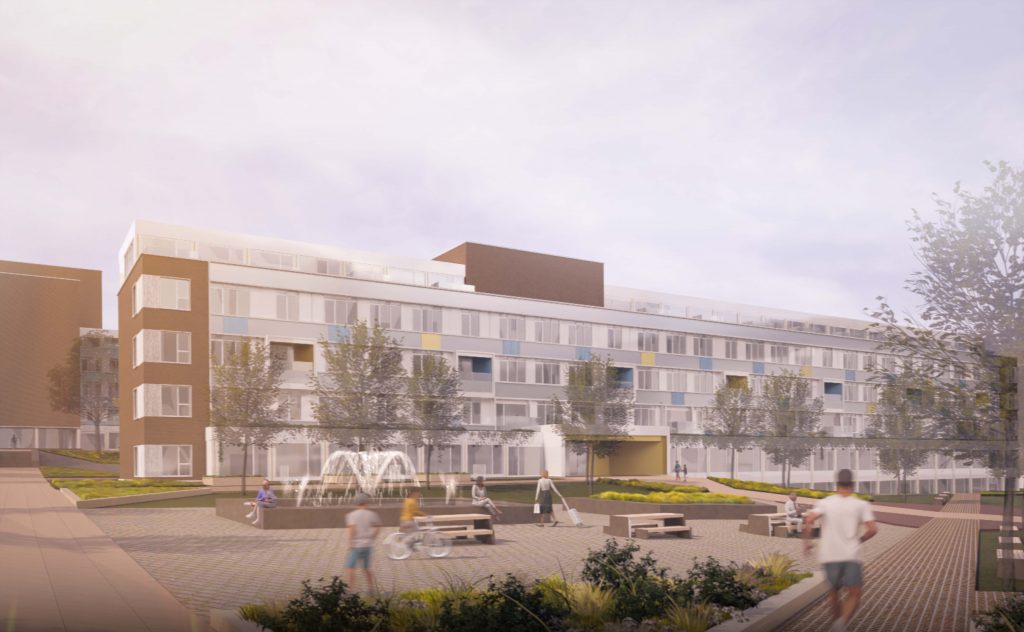

Clio re-envisions Ottawa’s Sir Charles Tupper Building as a vibrant 21st-century urban community, blending historical significance with modern living. This project enhances Confederation Heights with residential developments and pedestrian-friendly spaces. It addresses Heron Road’s barriers with a woonerf-inspired shared street aligned with the Tupper Building’s axis, creating a central spine that connects parking, plazas, commercial spaces, and a redesigned pedestrian tunnel. Interspersed green spaces and intersecting pathways cultivate community interaction and create a pedestrian-centric urban realm. The adaptive reuse preserves the building’s heritage with modern residential features, including semi-recessed balconies and rooftop terraces. Block A mixes commercial and residential spaces, using similar angular forms and vibrant colours to honour the site’s legacy.
Jury Comments: You managed to turn an office building into a residential building without creating a Frankenstein monster. The jury appreciated your approach to weaving in and out of the site and around the existing buildings and being able to capture the details at a master plan level. Tackling the building design with respect to the heritage attributes and re-using the colour scheme was very successful. The breakdown of the layouts of the units, again a tremendous success.
Honourable Mention ($750)
The 1960 Continuation
Emma Monfette and Danielle Pallo

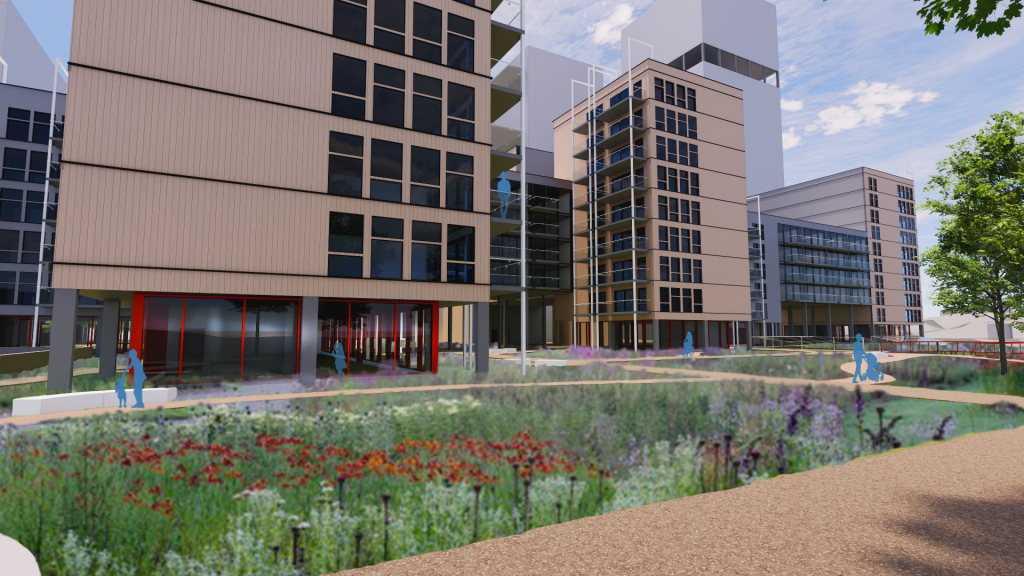
The 1960 Continuation seeks to utilize the abandoned Sir Charles Tupper Building and the adjacent unused surface parking as an opportunity to provide necessary housing and communal spaces to serve the current and future needs of the community. The development of the project was guided by the existing grid of the Sir Charles Tupper Building and a focus on transforming the single-use, car-centric area into an urban community geared toward the pedestrian and connection to nature and surrounding landscape. A diverse typology of housing allows residents to choose their preferred urban lifestyle. Outdoor gathering and community spaces, shaped by the edges of the surrounding buildings, offer a retreat into pockets of natural oases.
Jury Comments: The combination of a strong masterplan approach to the buildings creating scale, using the courtyards, and the re-invention of the upper-level buildings and how they interact together is an exemplary effort. Also, the acknowledgment of the Tupper Building and how you integrated that with your new design. You did a great presentation and that’s a skill in itself.
Honourable Mention ($750)
Vanier Unifié
Vanessa Jackson and Ariana Conidi


Vanier Unifié is a transformative urban initiative reshaping the heart of Ottawa’s Vanier district at the Montreal Rd. and Place Dupuis junction. The site plan aims to enrich the public space, focusing on revitalizing the existing pedestrian realm of Place Dupuis and linking it to a new community service centre. The project repurposes an existing office building, incorporating a nonprofit residence for women transitioning from foster care and employs a trauma-informed design approach. The development fosters connectivity and interaction across both sides of Montreal Rd., with townhouses featuring street-level access and residential towers seamlessly integrated into the north side of the site within the Vanier Community Service Centre.
Jury Comments: The combination of the high-rise profile and the mid-rise profile is quite successful arranged on top of that podium. Taking large buildings and architecturally breaking them down into smaller elements that go with the scale of the community really enhances the connectivity to what’s around. The open corner invites you into the site and into the courtyard.
Honourable Mention ($750)
Butternut Woods Village
Ruby Li and Kiana Ye
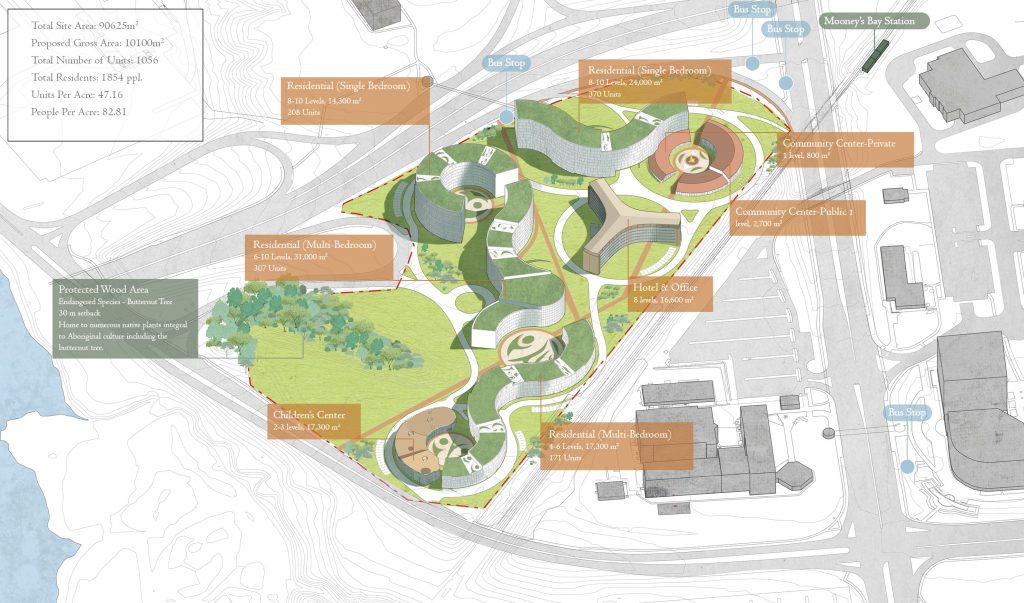

In the 19th century, the Canadian government’s cultural assimilation policies restricted Indigenous practices, child-rearing rights, and wealth accumulation opportunities. Today, Indigenous families, often large, grapple with housing shortages, and poverty, particularly in cities. These challenges echo the financial difficulties single mothers face today, especially concerning housing and childcare. Butternut Woods Village responds by offering affordable housing and childcare facilities. With the construction of an Aboriginal community center, the project offers a dedicated space for Aboriginal people to connect and engage in cultural practices. This community centre also seeks to attract visitors, offering an enriching experience that heightens their appreciation of Indigenous culture, thereby also supporting the local economy. The goal of this project is to build a community without isolation.
Jury Comments: It’s a very well-organized plan. We commend you on understanding the full scale of the site and the topography of the site and how all these buildings weave around the existing building, creating a unified experience. There are very clear sight lines from one side of the site to the next and the connection to the surrounding streetscape.
Honourable Mention ($750)
Village Heights
Rayannah Hwang and Dulat Sargaskayev

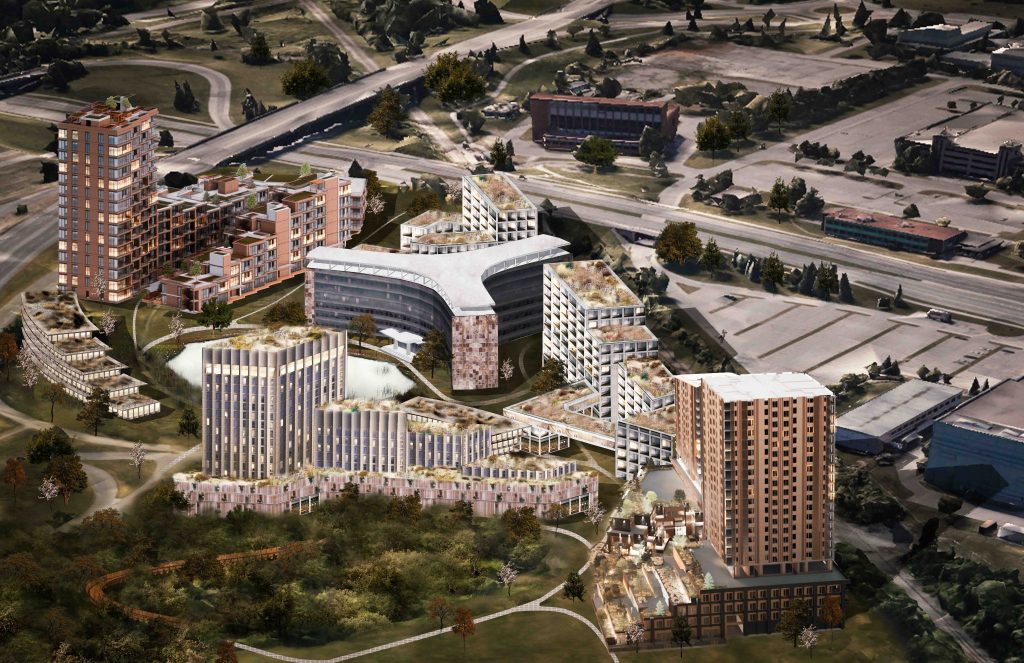
The arrangement of the proposed built forms is influenced by two key drivers: preserving iconic views of the CBC building from both Bronson Ave. and the Airport Parkway and celebrating open green spaces. The buildings create a sequence of semi-enclosed courtyards on a more intimate scale to encourage human interaction between residents. Both the open spaces and the courtyards are woven together by the network of active paths to choreograph one’s journey through the site. The ravine is an important ecological asset, and the light structure bridge allows users to be immersed in its nature. The second bridge on the site celebrates the approach to the CBC building, which will be primarily repurposed into housing, alongside community-oriented amenities.
Jury Comments: The renderings are beautiful. The more urban feel with streets and streetscapes is well resolved. The jury appreciated the approach to the building mass and how it relates to the ground plane, creating a strong pedestrian experience that leads through the greenspace surrounding the buildings.
About the Studio
The fourth-year housing studio, led by Associate Professor Benjamin Gianni, brings together students from all three undergraduate majors – Design, Urbanism, and Conservation and Sustainability.
The studio explores the development of multi-unit residential complexes on sites in Ottawa slated for intensification. Students work in pairs and with private-sector and not-for-profit developers as clients/partners.
The school worked with the Canada Lands Company and Public Services and Procurement Canada (PSPC) on two federal government office campuses in Confederation Heights: the CBC Building, and the Sir Charles Tupper Building.
Students were asked to consider how the existing buildings might be adaptively reused. They were also asked to consider how additional buildings might be located on the site to reach an overall density of about 200 persons per acre, consistent with the city’s targets for transit-oriented design.

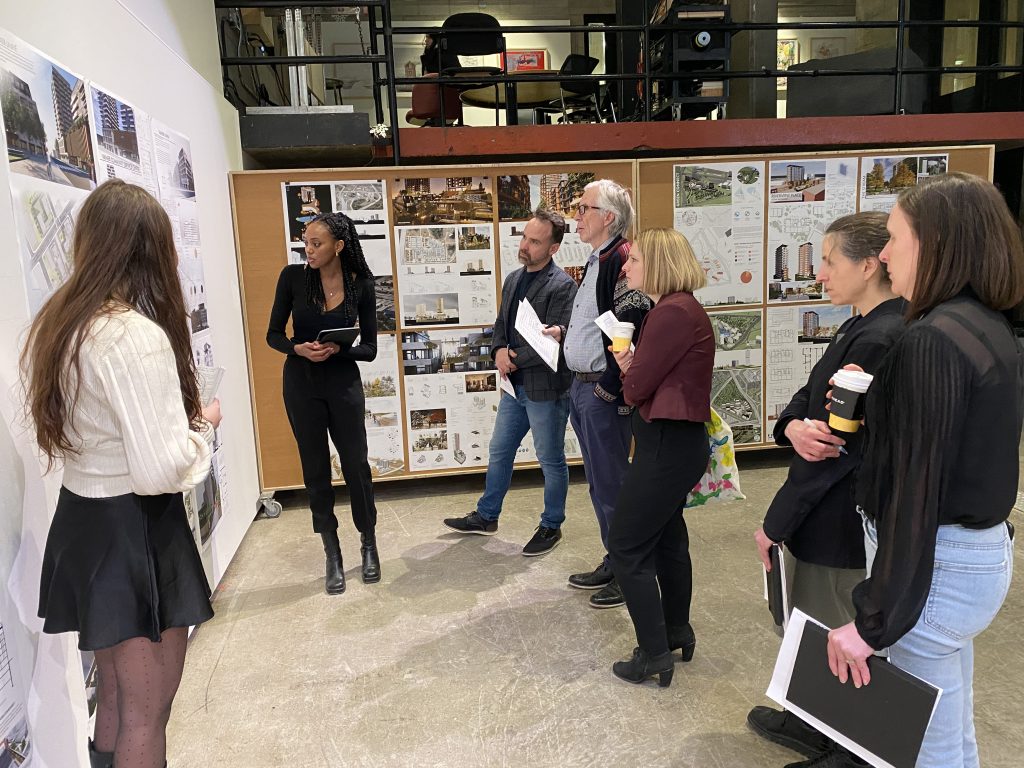
In Vanier, the students worked with:
The Child and Youth Permanency Council of Canada to adaptively re-use and add to an existing office building to accommodate housing for young women aging out of the foster care system.
The Vanier Community Service Centre (VCSC) to envision a new facility that accommodates their existing services plus a day care, several large meeting spaces, and market and affordable housing. Several of the teams explored the adaptive re-use and incorporation of the VCSC’s existing building (the Centre Francophonie) into the complex.
Being comprehensive in its scope, this studio addresses selected architectural questions through the detailed integration of site analysis, program development, master planning, concept development, placemaking, building components and systems, structure, materiality, and logic of construction.
It also addresses social issues related to housing supply and affordability.
“This studio’s project asks students not only to consider what constitutes great housing, but also the form and character of great streets, public places, neighbourhoods, and cities,” says Gianni.
“Their challenge is not only to design humane, flexible, and relatively dense, enclaves for demographically diverse communities of strangers, but to augment the quality and character of the urban environment.”